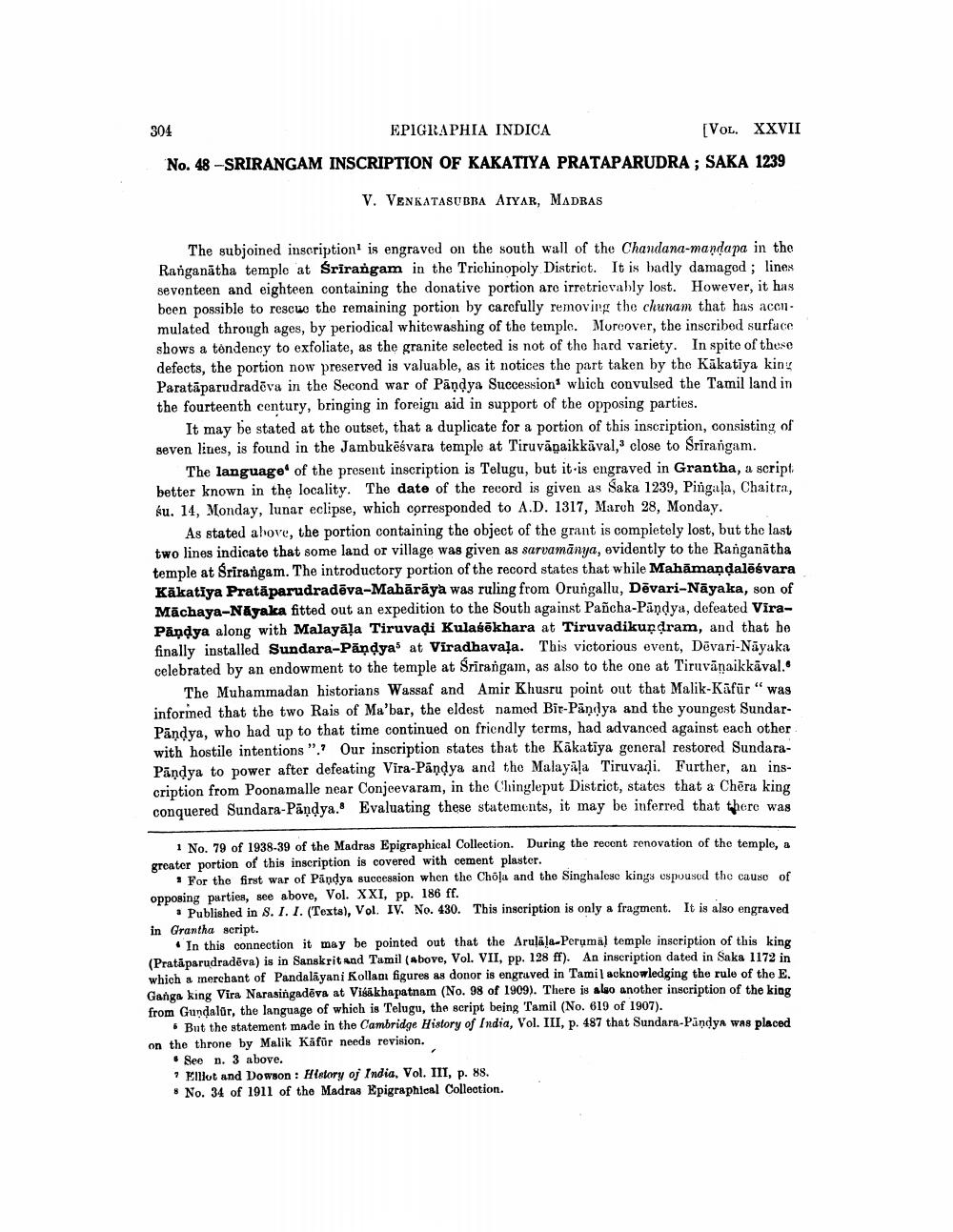________________
304
EPIGRAPHIA INDICA
[VOL. XXVII
No. 48-SRIRANGAM INSCRIPTION OF KAKATIYA PRATAPARUDRA; SAKA 1239 V. VENKATASUBBA AIYAR, MADRAS
The subjoined inscription' is engraved on the south wall of the Chandana-mandapa in the Ranganatha temple at Srirangam in the Trichinopoly District. It is badly damaged; lines seventeen and eighteen containing the donative portion are irretrievably lost. However, it has been possible to rescue the remaining portion by carefully removing the chunam that has accumulated through ages, by periodical whitewashing of the temple. Moreover, the inscribed surface shows a tendency to exfoliate, as the granite selected is not of the hard variety. In spite of these defects, the portion now preserved is valuable, as it notices the part taken by the Kakatiya king Parataparudradeva in the Second war of Pandya Succession which convulsed the Tamil land in the fourteenth century, bringing in foreign aid in support of the opposing parties.
It may be stated at the outset, that a duplicate for a portion of this inscription, consisting of seven lines, is found in the Jambukesvara temple at Tiruvaṇaikkaval, close to Srirangam.
The language of the present inscription is Telugu, but it is engraved in Grantha, a script. better known in the locality. The date of the record is given as Saka 1239, Pingala, Chaitra, su. 14, Monday, lunar eclipse, which corresponded to A.D. 1317, March 28, Monday.
As stated above, the portion containing the object of the grant is completely lost, but the last two lines indicate that some land or village was given as sarvamanya, evidently to the Ranganatha temple at Srirangam. The introductory portion of the record states that while Mahāmaṇḍalēsvara Kakatiya Prataparudradeva-Mahārāya was ruling from Orungallu, Dēvari-Nayaka, son of Machaya-Nayaka fitted out an expedition to the South against Pañcha-Pandya, defeated ViraPandya along with Malayala Tiruvadi Kulasekhara at Tiruvadikuṇḍram, and that he finally installed Sundara-Pandya at Viradhavala. This victorious event, Devari-Nayaka celebrated by an endowment to the temple at Srirangam, as also to the one at Tiruvāṇaikkaval.
The Muhammadan historians Wassaf and Amir Khusru point out that Malik-Käfür " was informed that the two Rais of Ma'bar, the eldest named Bir-Pandya and the youngest SundarPandya, who had up to that time continued on friendly terms, had advanced against each other with hostile intentions". Our inscription states that the Kakatiya general restored SundaraPandya to power after defeating Vira-Pandya and the Malayala Tiruvadi. Further, an inscription from Poonamalle near Conjeevaram, in the Chingleput District, states that a Chera king conquered Sundara-Pandya. Evaluating these statements, it may be inferred that there was
1 No. 79 of 1938-39 of the Madras Epigraphical Collection. During the recent renovation of the temple, a greater portion of this inscription is covered with cement plaster.
For the first war of Pandya succession when the Chola and the Singhalese kings espoused the cause of opposing parties, see above, Vol. XXI, pp. 186 ff.
Published in S. I. I. (Texts), Vol. IV. No. 430. This inscription is only a fragment. It is also engraved in Grantha script.
In this connection it may be pointed out that the Arulala-Perumal temple inscription of this king (Prataparudradeva) is in Sanskrit and Tamil (above, Vol. VII, pp. 128 ff). An inscription dated in Saka 1172 in which a merchant of Pandalayani Kollam figures as donor is engraved in Tamil acknowledging the rule of the E. Ganga king Vira Narasingadeva at Visakhapatnam (No. 98 of 1909). There is also another inscription of the king from Gundalur, the language of which is Telugu, the script being Tamil (No. 619 of 1907).
But the statement made in the Cambridge History of India, Vol. III, p. 487 that Sundara-Pandya was placed on the throne by Malik Käfür needs revision.
See n. 3 above.
Elliot and Dowson: History of India, Vol. III, p. 88.
No. 34 of 1911 of the Madras Epigraphical Collection.




